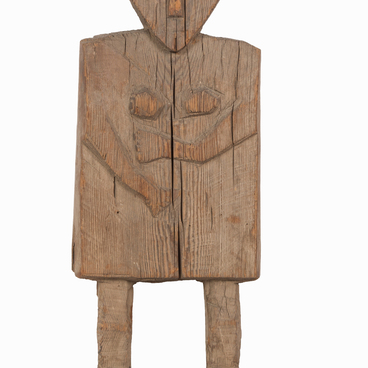The Udege people presented the Dym Yago Tyenku savan to Lieutenant Nikita Dmitrievich Kuzmin on the Bikin River in 1894. On this trip, the lieutenant collected 49 items of Udege culture, which he donated to the Grodekov Museum.
The ritual sculpture Dym Yago Tyenku was made for a shaman to serve as a helper and protector during the kamlanie ritual of communication with spirits. It was believed that the shaman got possessed by the savan, who increased his magical power during the transition to the Upper and Lower Worlds. According to the Udege elders, the Dym Yago Tyenku savan combined the images and power of several patron spirits, who could act one by one and, in case of extreme danger, together.
The tiger was the main patron. According to Udege beliefs, this animal was a sacred, honorable kin, a “man” of another kind. The Udege recognized its superiority in strength and finesse, and they exalted it to the rank of a deity. The sculpture is made in the shape of a tiger with wings. Thanks to the ability to fly like a bird, the spirit of the striped predator could easily pass to the Upper World.
The snake in the form of a lizard was viewed as an amphibious spirit. It was placed along the entire length of the back. It symbolized the connection with the Lower World. The gills on the lizard’s cheeks look like snakes. Their function was not only to enable swimming, but also to increase the strength of the jaws, which were equipped with a large fang.
The savan’s legs are strong. Its paws are bent, indicating that it is ready to leap, and it holds onto the ground with its three metal claws at the back. The circles under the wings near the front paws are toli mirrors. They were designed to fend off the power of evil spirits.
The tiger’s tail ends in a human head. This is Yaga — the most terrible tiger, the only one in heaven and earth. The Udege adhered to many prohibitions and customs related to the tiger. It was forbidden to kill it and eat its meat.
However, if the animal
attacked the hunter and he killed it, there was no sin in this case. In case of
a deliberate killing of a tiger, the dead animal was buried as a human being.
Two stakes with shavings were placed on the sides of the grave, which was built
in the form of a log cabin, showing that this place is prohibited.







